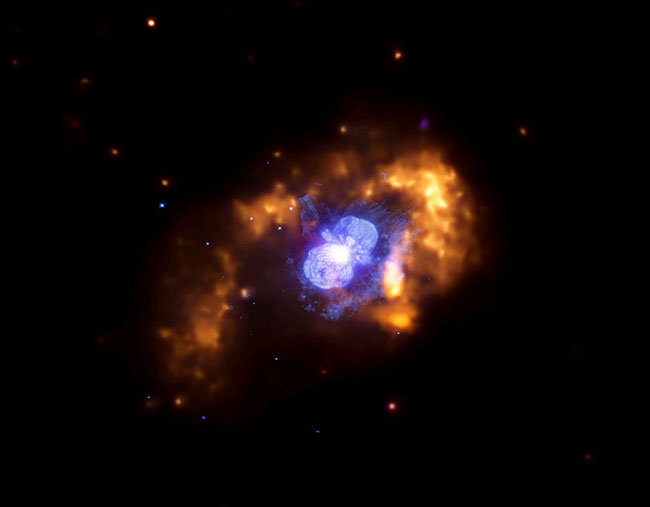New Risk to Earth Found in Supernova Explosions

An explosive star within our galaxy is showingsigns of an impending eruption, at least in a cosmic time frame, and has forquite some time. From 1838 to 1858, the star called Eta Carinae brightened torival the light of Sirius, the brightest star in the sky, and then faded to adim star. Since 1940 it has been brightening again, and scientists think EtaCarinae will detonate in 10,000 to 20,000 years.
Fortunately, Eta Carinae is far away, at least7,500 light-years from Earth. If it explodes, most of its energy will bescattered or absorbed in the vast emptiness of space. It also happens to betilted about 45 degrees from the line of sight to Earth, so any type of gamma-rayburst, a high-energy outburst expected with this star's eventual eruption,would miss the Earth. Cosmic rays would be diffused by magnetic fields, and mostof the damaging light would not affect life on Earth.
In general, threatsto life on Earth from supernovae are extremely small, for all except thenearest explosions — those 30 light-years away or closer.
But what if a supernova were 100 times brighterthan usual? Would there be any risk to life on Earth then?
Astronomers found such a record-breakingsupernova last year, SN 2006gy.
Brightest ever
SN 2006gy was the brightest supernova everrecorded until an evenbrighter one was discovered in November.
Breaking space news, the latest updates on rocket launches, skywatching events and more!
Astronomers now know the progenitor of SN 2006gywas remarkably similar to Eta Carinae. They warn a superluminous supernovamight explode right in our own galaxy.
Brian Thomas at Washburn University has beenstudying the effects of astronomical explosions at the Goddard Space FlightCenter. He decided to investigate what would happen to Earth's protective ozonelayer if Eta Carinae explodes with the brilliance of SN 2006gy.
It turns out that even though SN 2006gy was oneof the brightest supernovae ever recorded, it did not generate a large amount ofX-rays. Thomas and his team found most of the light, including damaging X-raysand cosmic rays, would scatter into space before ever reaching Earth.
So would there be any damage to Earth from sucha spectacular event? Though Thomas found X-rays and cosmic rays would causelittle damage, he also looked at optical light, particularlyshort-wavelength blue light (400 nanometers), where the spectrum of SN 2006gypeaked. No one had ever considered the effects of this light before, eitherfrom supernovae or any other type of event.
?The visible light could be significant,? Thomassays, ?But this depends a little bit on your definition of significant.?
Brighter than Venus
If Eta Carina were to explode like SN 2006gy, itwould quickly become the brightest object in the sky other than the sun and the moon.
For those living where Eta Carina is alwaysabove the horizon (Antarctica, New Zealand and extreme southern regions of Australia and South America) the light would vastly outshine Venus, visible even during the day. Theradiation would illuminate the evening sky with a bluish glow nearly strongenough to read by, and the effect would likely last for months — perhaps six ormore.
The cumulative effects of long-duration exposureto blue-enhanced light would begin to interfere with life on Earth.
Those who study chronobiology, or the effects ofbiological timing, have found that low levels of blue light can strongly affectthe endocrine systems of mammals by causing physiological and alertingresponses. Blue-enhanced light is associated with reduced levels of melatoninproduction and affects circadian rhythms. For these reasons, it is sometimesprescribed to counteract seasonal affective disorder (SAD) or winterdepression.
?This is not going to be an ?everything diesimmediately? kind of event,? Thomas said. ?But with the risk factors associatedwith higher levels of this kind of light it?s certainly something that could beimportant in the longer run.?
New threshold
In a paper about to be published in the journal Astrobiology,Thomas explains that even short exposures to blue light can increase insomnia,reduce resistance to infection and is being studied as a possible risk ofcancer.
Yet, in the case of Eta Carinae, the effect of theseoptical photons would be minimal. The scattering of photons by dust and gas isgreatest at blue wavelengths (thus giving Earth its blue sky) and the sheerdistance of Eta Carinae diminishes the optical intensity by about 20 percent.
But while damage from optical light is not a factorfor Eta Carinae, the effects of this light should be considered to any riskassessment of supernovae. Based on his results, Thomas now estimates the biologicalthreshold for supernovae to be about 100 light-years away. At that distance, lifeon Earth can expect some sort of supernova radiation about once every 20million years.
- Top 10 Ways to Destroy Earth
- Top 10 Star Mysteries
- The Strangest Things in Space
